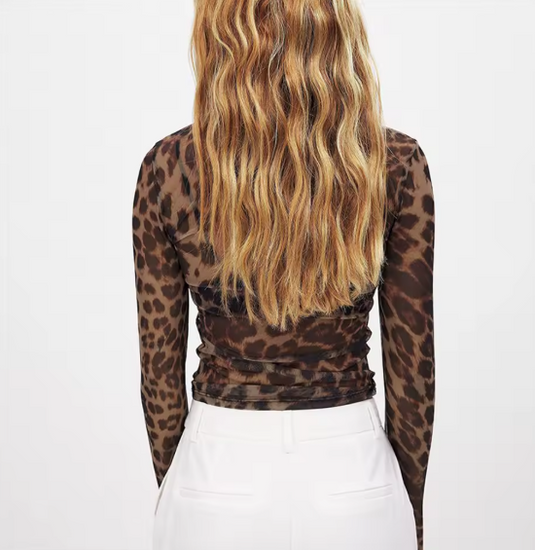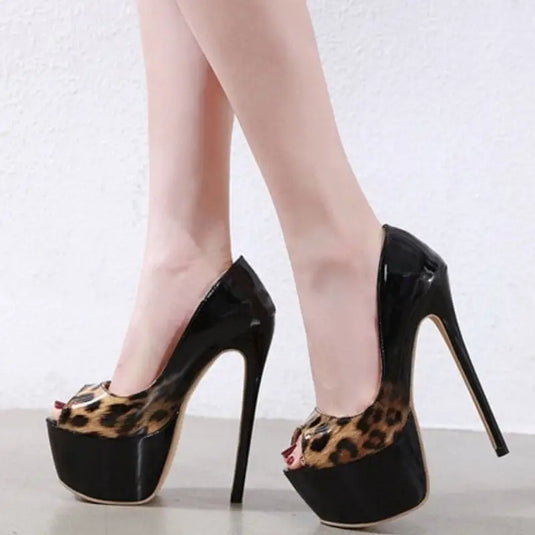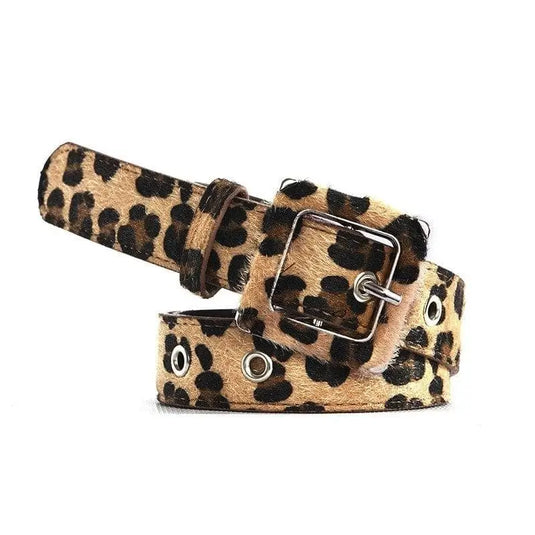I. Introduction
The iconic and bold leopard print has had a profound impact on the fashion world. From its early appearance to its status as a symbol of seduction, this fascinating pattern has captured the imagination of fashion lovers around the world.
In this in-depth exploration, we'll delve into the rich history and unique symbolism surrounding the leopard print , unveiling the complex layers of its evolution. Prepare for a journey through time, where leopard has transformed from a simple pattern into a bold style statement.
II. A Step into the Past: Origins of the Leopard Print
A. Historical origins and initial use
The leopard print's roots date back to ancient times, where it was used in a variety of contexts. In ancient Egypt, the leopard was revered and symbolized royalty. Meanwhile, in ancient Rome, the leopard print was worn by legionaries, evoking the leopard's power and fierce strategy.
Over the centuries, the leopard print has found its way into various cultures, becoming an iconic element of African tribal fashion and then spreading to other parts of the world. Its initial use was often associated with qualities such as strength, power, and mystery.
B. Evolution of the leopard pattern in different cultures
The evolution of the leopard print has been shaped by various cultural and geographical factors. While it was once associated with symbols of status and power, its use has evolved over time to become an aesthetic choice in the fashion world.
In Asian culture, the leopard print is often associated with spiritual beliefs and protection from evil. Conversely, in Western culture, the leopard print has been embraced as a provocative fashion statement. Its shift from leather to fabric marked a revolution in the perception of the pattern, propelling it to the status of a bold and alluring choice. The fusion of these diverse influences has resulted in a timeless fashion icon.
In short, the leopard print, with its rich historical origins and complex cultural evolution, has metamorphosed into much more than just a pattern; it embodies a fusion of symbolism, style, and boldness that continues to captivate the fashion world.
III. Symbolism of the Leopard in Nature
A. Characteristics of the leopard as a symbol
The leopard, as a symbol, draws its essence from the animal's impressive features in nature. The leopard's spotted coat , both elegant and camouflage, embodies duality in its symbolism. The black spots on a gold background represent stealth and intrigue. It's a visual reminder of how the leopard blends into its surroundings while still standing out with its unique appearance.
The leopard's stealthy nature, its ability to move silently and pounce with agility, are also elements taken into account in the symbolism. The leopard thus becomes a representation of contained power and controlled strength, traits that have found their way into the perception of the leopard print in fashion.
B. Reflection on the power and grace associated with the leopard
The symbolism of the leopard extends beyond its raw power to encompass captivating grace. The leopard's fluid movements in nature have inspired a stylized representation of grace in the world of fashion. The leopard pattern then becomes a visual expression of the power associated with femininity, creating a unique balance between strength and elegance.
The leopard's association with characteristics such as power, discretion, and grace makes it a complex symbol that transcends the boundaries of nature to become a source of inspiration in the world of fashion. Fashion designers have harnessed these symbolic elements to create pieces that go beyond aesthetics to convey a profound story.
IV. From Leather to Fabric: The Emergence of Leopard in Fashion
A. Transition of the pattern from leather to fabric
The evolution of the leopard print in fashion is marked by a significant transition from leather to fabric. While the leopard print was once associated with leather pieces, often symbolizing wildness and rebellion, its introduction into the world of fabric opened up new perspectives. This transition allowed for play with the texture, lightness, and versatility of the pattern.
Leather, while retaining its rebellious aura, has given way to fluid fabrics that have brought a more accessible dimension to the leopard print. This adaptation has allowed leopard to be integrated into a variety of styles, from haute couture to ready-to-wear , thus offering an expanded palette for fashion designers and style lovers.
B. First notable appearances in the world of fashion
The first notable appearances of the leopard print in the fashion world date back to the early 20th century. Visionary designers began incorporating leopard into their collections, transcending its initial use in military and tribal designs. Iconic names such as Christian Dior helped popularize the pattern, transforming it from an eccentric choice into a sophisticated style statement.
The 1940s saw the emergence of leopard print as a symbol of glamour and bold femininity. Style icons like Marilyn Monroe helped solidify its status by sporting it with confidence. Since then, the leopard print has been reinterpreted in endless ways, becoming a timeless and versatile element that transcends generations and fashion trends.
In short, the transition from leather to fabric and the first notable appearances defined the leopard print's path in fashion, giving it a prominent place in the contemporary sartorial landscape. The symbolic nature of the leopard also added significant depth to its adoption in the fashion world, making the leopard print much more than just a passing trend.
IV. From Leather to Fabric: The Emergence of Leopard in Fashion
A. Transition of the pattern from leather to fabric
The fascinating history of leopard print in fashion is characterized by a significant transition from leather to fabric. Initially associated with leather pieces, the leopard print embodied wildness and rebellion, creating a bold aesthetic. However, with the evolution of fashion trends and the search for new artistic expressions, leopard print made its transition to the world of fabric.
This transition brought a radical shift in the perception of the pattern. Leather, often associated with a rebellious attitude, was complemented by lighter fabrics, giving the leopard print a new dynamic. Designers began experimenting with the texture, fluidity, and versatility of the fabric, allowing leopard to adapt to a variety of styles, from haute couture to everyday wear. This leopard print jumpsuit perfectly embodies the pattern's versatility.

B. First notable appearances in the world of fashion
The leopard print's first notable forays into the fashion world date back to the early 20th century. Visionary designers introduced leopard print into their collections, marking the beginning of its rise as a style symbol. This early adoption helped break conventions and integrate the pattern into the realm of haute couture.
The 1940s were a pivotal period, when leopard print became synonymous with glamour and bold femininity. Style icons such as Marilyn Monroe helped popularize leopard print by sporting it with confidence, propelling the pattern to the forefront of the fashion scene. Since these first notable appearances, leopard print has continued to evolve, becoming a staple in the collections of renowned designers and a popular choice for fashionistas worldwide.
V. The Leopard as a Symbol of Rebellion and Audacity
A. Analysis of the period when leopard becomes a bold choice
The emergence of leopard print as a bold pattern coincided with periods of social and cultural upheaval. In the 1920s, the post-war era and women's emancipation ushered in a new fashion expression. Leopard print, with its wild and provocative aura, became a bold choice for those seeking to challenge established norms.
In subsequent decades, leopard print continued to be associated with rebellion, particularly in cultural movements such as punk in the 1970s. Stylists and fashionistas embraced the leopard print as an anti-conformist statement, placing it at the heart of alternative fashion and counterculture.
B. Impact on the perception of fashion and femininity
The choice of leopard as a bold pattern radically transformed perceptions of fashion and femininity. While previous fashions were often associated with restraint and tradition, the introduction of leopard brought a rebellious energy and a provocative attitude. Women wearing leopard were perceived as confident, independent, and ready to challenge conventions.
The impact also extended to redefining standards of beauty and femininity. Leopard print transcended preconceived notions of feminine elegance, offering a bold and powerful alternative. In this way, the leopard print helped expand the range of clothing options available to women, encouraging individual expression and celebrating diverse styles.
In short, the era when leopard print became a bold choice left an indelible mark on fashion, revolutionizing the way we perceive rebellion, boldness, and femininity. This pattern, once declared provocative, is now a symbol of confidence and self-affirmation, transcending eras with its ability to remain relevant and powerful.
VI. Seduction and Confidence: Leopard as a Style Choice
A. Exploration of the seduction associated with the leopard pattern
The leopard print has always been intrinsically linked to seduction. Its tumultuous history in fashion has consistently evoked notions of mystery, sensuality, and power. Exploring the seduction associated with the leopard print reveals this aesthetic's unique ability to capture the imagination and spark attraction.
The allure of leopard lies in its balance between wildness and elegance. The distinctive spots evoke the leopard's natural beauty and grace while also adding a bold and provocative dimension. Fashion designers have embraced this duality, creating pieces that flatter the figure while also exuding an aura of mystery. For example, this leopard dress perfectly illustrates the provocative and seductive side. Thus, the leopard print becomes a visual language of seduction, allowing its wearers to convey fearless confidence.

B. How the pattern inspires confidence in those who wear it
The leopard print goes beyond its visual appeal to inspire a deep sense of confidence in those who wear it. By adopting leopard, individuals often demonstrate bold assertiveness and an acceptance of their own personal power. The pattern becomes a stylistic armor, strengthening inner confidence and projecting an image of strength and determination.
The confidence inspired by leopard print comes from its ability to transcend cultural norms and defy expectations. Wearing leopard print isn't simply a style choice; it's a statement affirming that a person is ready to assert themselves, explore their individuality, and claim their space in the fashion world. This confidence isn't superficial; it stems from self-awareness and acceptance of one's uniqueness.
VII. Conclusion
A. Summary of key points
Summarizing this journey through the history, symbolism, and evolution of the leopard print in fashion, several key points emerge. Initially a bold style choice, leopard print has evolved to become much more than just a pattern. It embodies seduction, rebellion, and confidence, offering individuals a powerful way to express themselves through fashion.
B. Affirmation of the leopard as a timeless symbol of seduction and audacity
In conclusion, the leopard remains a timeless symbol of seduction and boldness. Its journey through time and cultures attests to its ability to remain relevant, influential, and provocative. By choosing leopard, everyone can take ownership of a piece of this history, engaging in a continued exploration of seduction, self-confidence, and self-expression. The leopard, much more than a pattern, is a style statement that transcends the limits of time and convention.






